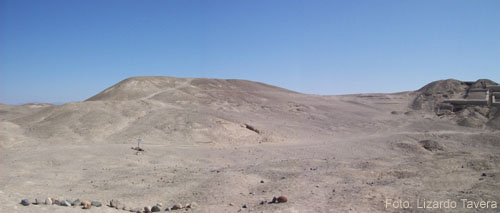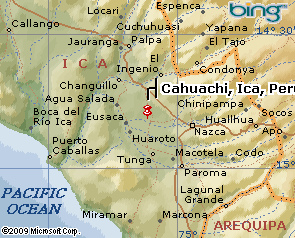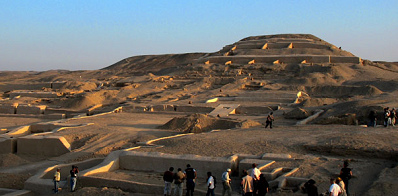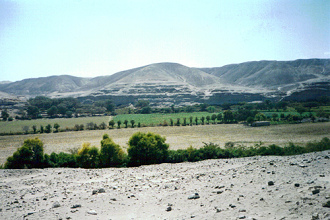Cahuachi
"World wide greatest ceremonial center of mud bricks"
Manner of work - Mr. Dr.
Giuseppe Orefici
<All what is shown here by Dr. Giuseppe Orefici refers to
145 excavation sites which are spread over 22 different
temple sites. Add to this all excavations were confirmed by
C14 method. There could be made out 80 different
datings.> (p.6)
<Sometimes Nasca River is overground, sometimes
underground. That's because the feeding rivers are
different.
But in the past this was seen in another way - as a magic
performance as if there was a supernaturally will of the
goddess; and by this the Cahuachi region was seen as a holy
land since 2500 years of course.
Without any doubt the systematic and interdisciplinary works
of the Archeologic Research Center of pre-Columbian Times
("Centro de Investigaciones Arqueológicas Precolombinas") -
presided by Dr. Giuseppe Orefici - can give a global
impression of that what really meant Cahuachi.
There are only a few studies about Cahuachi with basic and
consequent work, and which provoked more archaeological
works, for example by William D. Strong (1952-53) and
Helaine Silverman (1984). But since 1984, since Dr. Giuseppe
Orefici is working here with his Archeologic Research Center
of pre-Columbian Times, it can be estimated what Cahuachi
really meant - with systematic and interdisciplinary
excavation activities.> (p.3)
[The periods of Cahuachi
near Nazca]
<Thanks of precious studies we can see a chronological
correct frame today about the population of the region in
former times. For example there were detected remnants of
the so called "Man of Pyramid 2" from pre-ceramic times
(from the year 4282 BC). And we can follow the interesting
constructive process of Cahuachi (400 BC - 300 AD), until
the whole ceremonial center was left in 400 AD.> (p.3)
<At lower level the ceremonial life was going on up to
the end of the first millennium] (p.11-13) [until another
big flood came and covered the places with it's mud.>
(p.13)
<To understand better the process of Cahuachi we can part
the epoch in five phases>:
[4282-400 BC: no indications, eventually strong contact to
spacecrafts of the extraterrestrials]
<a) Formative phase (400-100 BC).
- the place gets a holy significance
- the buildings are isolated
- walls of reed without any base
- the population lets dominate itself by the priest's
community.
b) time of prosperity (100 BC-100 AD).
- the place becomes a ceremonial center
- erection of architectonic monumental buildings
- erection of the "Temple of Stairs" ("Templo del
Escalonado")
- use of different conical mud bricks.
c) monumental phase (100-300 AD).
- the place becomes theocratic main town
- architecture is developing highest levels concerning
constructions
- erection of the "Great Pyramid" ("Gran Pirámide") and of
the "Great Temple" ("Gran Templo")
- use of mud bricks in forms of bread (p.4).
d) leaving times (300-400 AD).
- the town is going on being theocratic main town
- there are some changes
- other temples are integrated to life
- the base is filled with vegetable fillings (plectomorph
technique)
- use of different types of mud bricks in an unsophisticated
way
- and then came a big flood
- and then were times of crises
- and then the population began to leave the spot.
e) trial of restart (450-500 AD).
- the walls are destructed
- the trial of a restart fails
- the spot is turning into a big necropolis
- the spot is turning into a holy spot
- population is migrating up the valley> (p.5)
f) holy cults are performed in little centers, e.g. in the
Temple of Stairs (p.11-13)
g) another big flood with mud] "at the end of the first
millennium" [brings religious activity to a definite stop.
(p.13)
[The climax of development
of the religious center of Cahuachi - over 30 pyramid
temples - pilgrims and prophecy]
<Cahuachi at it's climax had a territory of 24 km
2.
Until today there could be made out over 30 pyramid temples.
At the same time there is the question how this religious
center with it's big size had functioned. There is no doubt
that this was the place with the most important religious
presence of today's Peruvian South. That's why the thesis
can be derived that Cahuachi turned into a big pilgrim
center from time to time. There were thousands of
pilgrims who wanted to listen to the hundreds of local
priests to their prophecies. To become a better idea of
Cahuachi one could comprehend this place as a "pre-Spanish
Vatican".> (p.7)
[The hypothesis that the
Plains were a ceremonial center of the pyramids]
<Today Cahuachi is separated from the big Plain ("Pampa")
of Jumana or San José by the long Nasca Valley, and when we
admit the hypothesis that the Plain with it's tremendous
geoglyphs was an open ceremonial center where rites of
reconciliation for water or fertility were performed, so it
could have been a "temple without walls" and we can conclude
that there had been a logic and strong link between the
plain and the population of Cahuachi.> (p.7)
[Supplement: Hypothesis
that the plain was a big calendar and after that was a
ceremonial center - and there are elements of the flight
paths of the spacecrafts of the extraterrestrials
First there was a big panorama from the pyramids to the
plain ("Pampa") with it's lines. Then the mudslides
interrupted the panorama, and this did not change until
today. The Nazca lines are in connection with the pyramids
because some lines are pointing directly to the pyramids.
It's perfectly possible that the lines were a calendar, or
when there were 30 pyramids, there are 30 calendars one upon
the other. This would explain the chaos of lines in the
plain.
The hypothesis of an open ceremonial center in the plains
does not seem right - or there was first the calendar, and
after the mudslides there were added new pictures for a
ceremonial center. Add to this it's striking that the
geoglyphs show elements of the flight paths of the
spacecrafts of the extraterrestrials (helices and zig-zag
lines). The case of the lines seems to be very complex].
[Pyramid's architecture of
Cahuachi near Nazca: details]
<Cahuachi architecture is the most representative of
Nazca culture. Here are prescribed some aspects and used
elements in their development:
Mud bricks: in conical form, big ones and small ones, with
incisions or grooves; and there were mud bricks in form of
bread in elliptic form, big ones and small ones.
Living areas and rooms: They were constructed in different
sizes, with thick and high walls, in some cases with a
height of 3 m and with 1 to 2 m thick walls. The roofs were
made of reeds with beams of huarango trees, with columns and
forked beams also of huarango.
Plaster and painting: In this case there was used fine clay.
The colors of rose, dark red and glaring red are striking.
Platforms: There was often used the form of the hills for
the construction of the platforms, and in other cases there
were made steps and the steps were filled with vegetable
material (plectomorph technique), and this was the base for
the floors.
Stairs: There were no long stairs, and generally they were
angular and not straight-line. The surface of the steps was
protected by huarango wood to evade a wastage by the walking
people.
Entrance doors: There were only some few entrance doors to
control well the entrance to the temples.
Columns: The structure's base is a strong columns of
huarango. At the top a wheel of reed is fixed (thin poles),
and this was kept together by a vegetable netting which was
laminated by clay from inside and from outside. By this the
arch looked like one single column which could reach 3 or 4
m of height. In this way heavy roofs were supported, and
they were decorated with splendid colored cornices.
Floors: There were made floors with dried clay and water,
and in many cases there were given offerings in it, pottery
in pieces or as a whole.> (p.8)
[The destruction of
Cahuachi by earthquake and tremendous floods of mud
between 350 and 400 by a mega niño - the shock in the
population referring to their gods]
<It's relatively difficult - as also with other world
cultures - to make an interpretation of the evolutionary and
socio-political reasons of a population with it's economical
and religious factors. It was not easy to interpret the
traumatic decline of Cahuachi. As Dr. Orefici says the
destruction of Cahuachi was caused by two natural events (
an earthquake followed by a
tremendous flood) which happened between 350 and
400 AD.
These events must have had a horrible effect to the
population of Nazca because also the roofs of the temples
broke down by the weight of the water by the heavy and never
ending rains by the historic mega niño. The floods destroyed
the walls, platforms and the columns, and by this there
remained only an unusable and grim landscape. By this the
population was forced to a change referring to their habits
and their intellectual world. Dr. Orefici says there was a
big lack of understanding and unbelief referring to the
gods: The population blamed the gods themselves of the
destruction of the splendid temples which were dedicated to
the gods.> (p.6)
[The destruction of the
rests of the temples by the survivors - new sacrificial
rituals]
<Now there is a hypothesis that the survivors answered
with some actions at this chaos with the idea to calm down
the fury of the gods. These actions were:
a) destruction of the whole site
b) holy sacrificial rituals in a big stile
c) to put fire on the temple structures.> (p.6)
<This destruction took place in one or two Dantesk big
fires which left their traces, for example clay in the
temple walls in quincha technique was melt to glass by the
high temperatures. With the big fire and the fuming rubble
which had been once the theocratic main town of Nasca there
were erected now little structures without any great effort
of before, with the aim to give sacrifices. These were
peaces of ceramic which were produced only for this purpose,
and also humans and animals were sacrificed.> (p.7)
[Sealed ruins]
<Then there was an action which is not declarable until
now and which is suppressed in the public debate until now.
Dr. Orefici says that this action was one of American
cosmocentrism. The rubble of the pyramid temples were
covered with fillers of the activities before, and there
were many sacrifices within the fillers, which was a hard
work for the researchers of nowadays to identify and to
classify the broken pieces.
As a last action the survivors of Cahuachi were sealing all
the remaining temple structures with a thick layer of clay;
by this glamour and monumentality of Cahuachi should be a
part of the past, and by this the site was converted
by their own population into a proverbial necropolis for all
the time, but there were yet the following phases 5, 6 and 7
of Nasca with corresponding activities.> (p.7)

The sealed ruins of today look like a landscape of
hills... [5]
With the sealing of the temples there were put skulls as
sacrifice ("cabezas-ofrenda") at the entrance doors as an
act of magic religiosity. (p.11)
The cultural activities were performed at other pyramids
aside, for example at the "Temple of Stairs" ("Templo del
escalonado"), see the Temple of Stairs (pyramid with stair
design, with column area). (p.11-13)
<Ramps: In the last phase ramps were built at the lasting
pyramids to facilitate the access to the upper platforms.
The ramps were built with remains of broken walls caused by
the earthquake.> (p.8)
[Another huge flood and
destruction "at the end of the first millennium" = 900 to
1100 AD]
<At the end there has to be mentioned that the
archeologic excavations at the column area ("Estaquería")
[at the "Temple of Stairs" ("templo del escalonado")] make
it clear that there happened another
flood catastrophe with mud and
debris which affected the Nasca region at the end
of the first millennium AD, and this was much worse than the
catastrophe which had affected Cahuachi hundreds of years
before.> (p.13)
[The new situation: The
blocked panorama from the pyramids to the lines of Nasca
by mud and debris avalanches]

[6]
[The sight from the pyramid zone to the Nasca valley: First
there was a panorama here, and one could see the plain with
all it's lines. But the river is dangerous: Since the big
floods the sight is blocked by mud and debris avalanches.
The river twice created a new riverbed, but the rests of the
mud and debris avalanches stay and are blocking on the
panorama on the lines, and perhaps there can be found more
artifacts and rests in this line of hills...]
Antonini Pyramid Museum, Nasca
(Museo Antonini de las pirámides de Nasca)
Avenida La Cultura 600
Nasca
Tel. 0051-(0)56-523 100 / 523 444
cahuachi@terra.com.pe
Auspices of the booklet:
Casa Andina
Peruvian hotel chain
Bulevar Bolognesi 367, Nasca
Tel. 0051-(0)56-523 563
[6]






